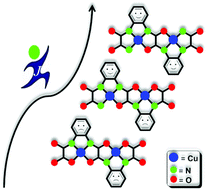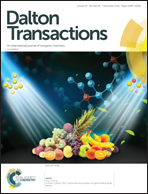Promotion of antiferromagnetic exchange interaction in multinuclear copper(ii) complexes via fused oxamato/oxamidato ligands†‡
Abstract
Treatment of N,N′-bis(2-aminophenyl)oxalamide (bapoxH6, 1) with ethyl oxalyl chloride in THF afforded oxamide-N,N′-bis(o-phenylene oxamic acid ethyl ester) (L1H4Et2, 2), which was converted to 3 (oxamide-(o-phenylene oxamic acid ethyl ester)(o-phenylene-N1-methyloxalamide); L2H5EtMe) and 4 (oxamide-N,N′-bis(o-phenylene-N1-methyloxalamide); L3H6Me2) by the addition of appropriate equivalents of MeNH2. Successive treatment of 2–4 with six equivalents of [nBu4N]OH and two equivalents of CuII salt resulted in the formation of the binuclear complexes [nBu4N]2[Cu2(L1)] (5), [nBu4N]2[Cu2(L2Me)] (6) and [nBu4N]2[Cu2(L3Me2)] (7). Upon addition of one equivalent of [Cu(pmdta)(NO3)2] (pmdta = N,N,N′,N′′,N′′-pentamethyldiethylenetriamine) to 5–7, the trinuclear complexes [Cu3(L1)(pmdta)] (8), [Cu3(L2Me)(pmdta)] (9) and [Cu3(L3Me2)(pmdta)] (10) were obtained, while the addition of two equivalents of [Cu(pmdta)(NO3)2] gave rise to the tetranuclear complexes [Cu4(L1)(pmdta)2](NO3)2 (11), [Cu4(L2Me)(pmdta)2](NO3)2 (12) and [Cu4(L3Me2)(pmdta)2](NO3)2 (13). The identities of compounds 2–4 were established by elemental analyses, NMR and IR spectroscopy, and ESI-MS measurements. For the multinuclear complexes 5–13, elemental analysis and IR spectroscopy were applied to confirm their identities. Furthermore, the solid-state structures of 5–8 and 11–13 were determined by single crystal X-ray diffraction studies. The magnetic behavior of 5–8 and 11–13 was studied by direct current susceptibility measurements as a function of temperature. For the binuclear complexes 5–7, exceptionally large antiferromagnetic exchange interactions with J1,2 values of −378, −397 and −419 cm−1 were determined. Astonishingly, the tendency of these series of magnetic exchange interactions can be smoothly associated with the d–d transitions of 5–7 measured through UV-Vis spectroscopy. The J1,2 value of 8 amounts to −507 cm−1, while for the tetranuclear complexes 11–13, this value is significantly smaller and amounts to −294, −292 and −370 cm−1. The second antiferromagnetic exchange interactions J2,3 and J1,4 are equal due to inversion symmetry and are −100, −135, −80 and −108 cm−1 for 8 and 11–13, respectively, in the expected range. Magneto-structural correlations are used to discuss the variable magnetic exchange interactions of all here reported multinuclear complexes.



 Please wait while we load your content...
Please wait while we load your content...